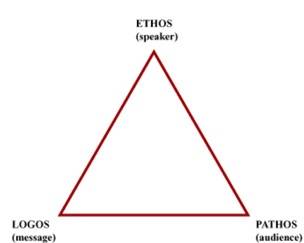Argumentation
Rhetorical Triangle
Logos: Logos refers to logic. What types of evidence and data are you including within your message to help support your claims? Using facts, statistics, and expert testimonials from credible sources assists in building a more sound argument.
Ethos: Think of this as the ethics of the speaker, as well as your authority to deal with this particular topic. Including a credibility statement in the introduction of a presentation is an effective way to build ethos and inform your audience about why you are able to speak on this topic.
Pathos: Pathos refers to passion and the emotional appeals your argument makes. In short, it is the ability to create a relationship with the audience. How do you connect with them and get them to care about your argument?

Now that we have the audience in mind and understand the interplay between Ethos, Pathos, and Logos, here are some helpful tips to make your argument effective.
Evidence
Evidence should be used to support all of your major claims and is crucial to an argument.
Be Specific as you Can: It is better to tell the audience an exact statistic on the number of deaths that occur each year from drunk driving than to just say "Many people die from drunk driving each year." This will improve both the credibility you have as a speaker as well as the credibility of your message. And yes, it is OK to round to an even number.
Use Novel Evidence: It is difficult to change minds with information that your audience already knows. The chance to persuade comes from either new information you present to your audience or creative and novel ways of interpreting and presenting old and well known information. This is part of the cognitive dissonance process.
Use Credible Sources: In order to come across as honest and correct, it is important to use sources that are objective in the eyes of your audience. For example, when discussing the safety of offshore drilling, are you more likely to believe testimony from an impartial marine biologist or a BP executive?
Reasoning
It is important to support your claims using concrete analysis. Here is some information that describes the basic structure of how we normally organize our thoughts.
From Specific Instances (Inductive): This form of reasoning takes specific examples and then makes a generalization from those examples. Example: My father is a businessman and always wears a tie, my uncle is also a businessman and always wears a tie, and my neighbor is a businessman and wears a tie. So, all business men wear ties. Be very careful with this form of reasoning, as it can easily lead to hasty generalizations that are not proven with the evidence at hand.
From Principle (Deductive): Here we move from a generalization and apply it to a specific example. When reasoning in this way it is crucial to provide evidence to support/prove your general principle. For example, all people are mortal, Socrates is a person, therefore, Socrates is mortal.
Fallacies: A fallacy is an error in logic and or reasoning that detracts from the legitimacy of your message. For more information on fallacies, click here.
Information adapted from Stephen Lucas' The Art of Public Speaking, Tenth Edition.

